
 |
Home | Libraries | People | FAQ | More |
(Testing program at perf.cpp.)
We ran tests to measure the performance of the containers of Boost.PolyCollection in two scenarios:
std::for_each
and boost::poly_collection::for_each (with and without type
restitution).
As a comparison baseline we used containers and facilities from the standard library and Boost (details below). Tests were run in the following environments:
ptr_vector
= boost::ptr_vector<base>
base_collection
= boost::base_collection<base>
T1 =
derived1, T2 = derived2,
T3 = derived3
struct base { virtual ~base()=default; virtual int operator()(int)const=0; }; struct derived1 final:base { derived1(int n):n{n}{} virtual int operator()(int)const{return n;} int n; }; struct derived2 final:base { derived2(int n):n{n}{} virtual int operator()(int x)const{return x*n;} int unused,n; }; struct derived3 final:base { derived3(int n):n{n}{} virtual int operator()(int x)const{return x*x*n;} int unused,n; };
func_vector
= std::vector<std::function<int(int)>>
function_collection
= boost::function_collection<int(int)>
T1 =
concrete1, T2 = concrete2,
T3 = concrete3
struct concrete1 { concrete1(int n):n{n}{} int operator()(int)const{return n;} int n; }; struct concrete2 { concrete2(int n):n{n}{} int operator()(int x)const{return x*n;} int unused,n; }; struct concrete3 { concrete3(int n):n{n}{} int operator()(int x)const{return x*x*n;} int unused,n; };
any_vector
= std::vector<boost::type_erasure::any<concept_>>
any_collection
= boost::any_collection<concept_>
T1 =
int, T2
= double, T3 = char
using concept_=boost::mpl::vector< boost::type_erasure::copy_constructible<>, boost::type_erasure::relaxed, boost::type_erasure::typeid_<>, boost::type_erasure::incrementable<> >;
Tests measure the time taken to insert n elements (n between 102 and 107) from a source of values with types following the cyclic sequence
T1 T1
T2 T2
T3 T1
T1 T2
T2 T3
···
No reserve operation is done
before insertion. The figures show resulting times in nanoseconds/element.
The horizontal axis is logarithmic.
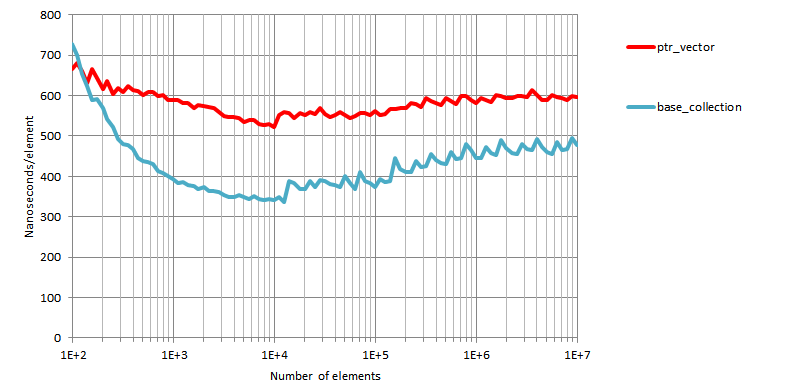 Insertion, Visual Studio
2015 x86
Insertion, Visual Studio
2015 x86
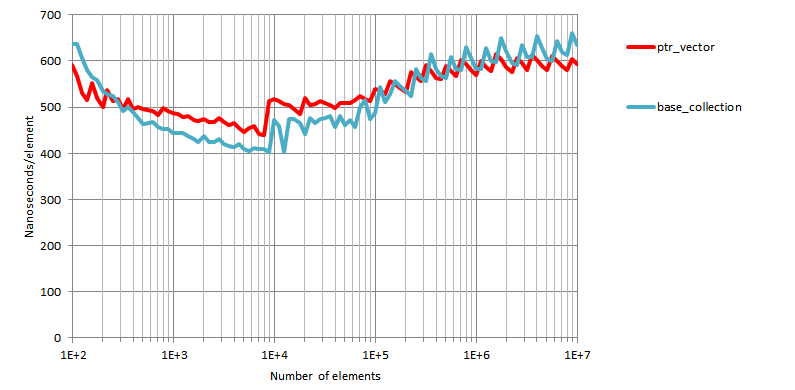 Insertion, Visual Studio
2015 x64
Insertion, Visual Studio
2015 x64
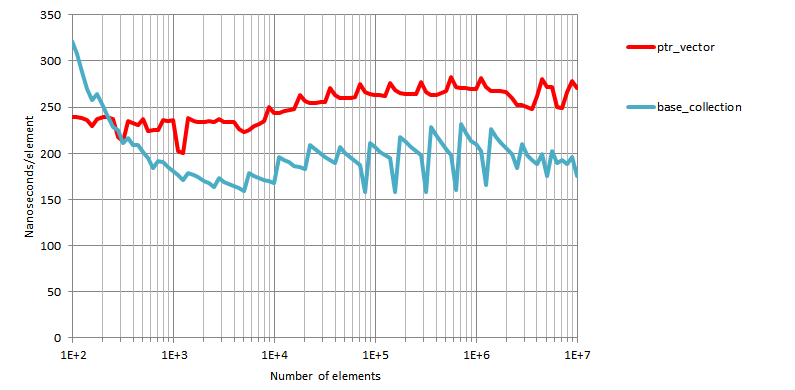 Insertion, GCC 6.3 x64
Insertion, GCC 6.3 x64
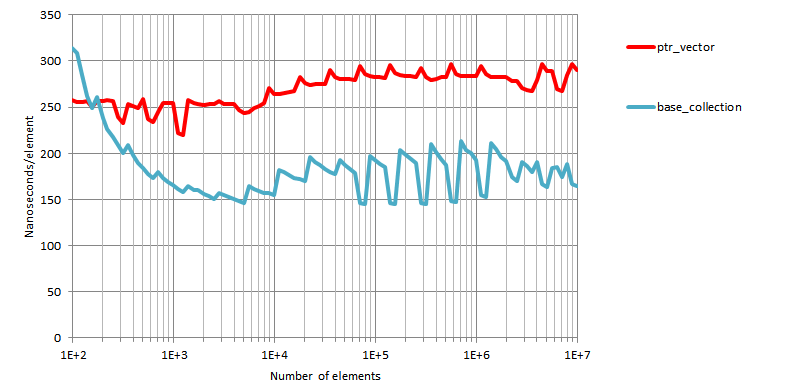 Insertion, Clang 4.0
x64
Insertion, Clang 4.0
x64
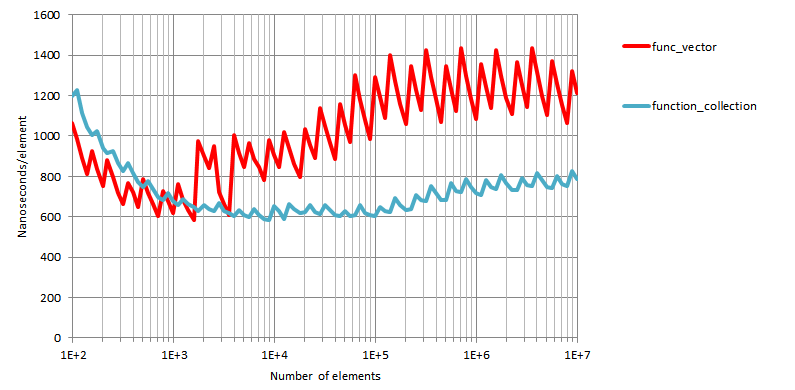 Insertion, Visual Studio
2015 x86
Insertion, Visual Studio
2015 x86
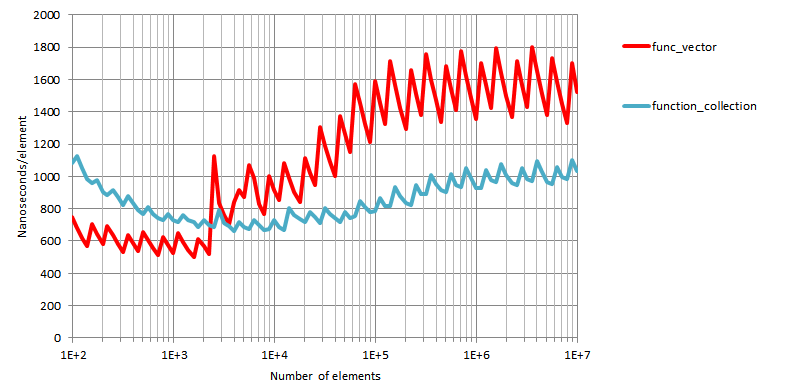 Insertion, Visual Studio
2015 x64
Insertion, Visual Studio
2015 x64
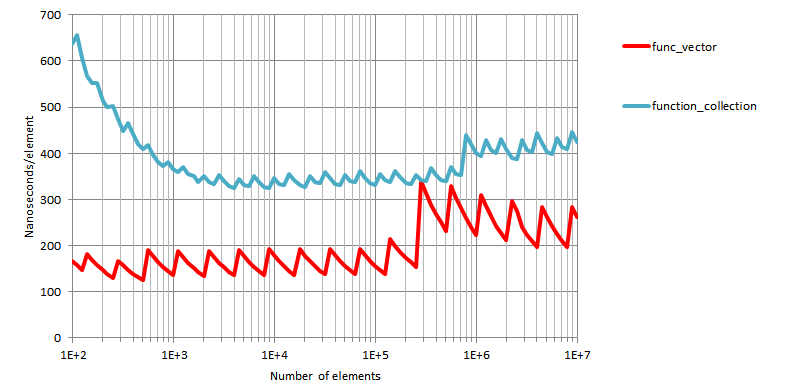 Insertion, GCC 6.3 x64
Insertion, GCC 6.3 x64
 Insertion, Clang 4.0
x64
Insertion, Clang 4.0
x64
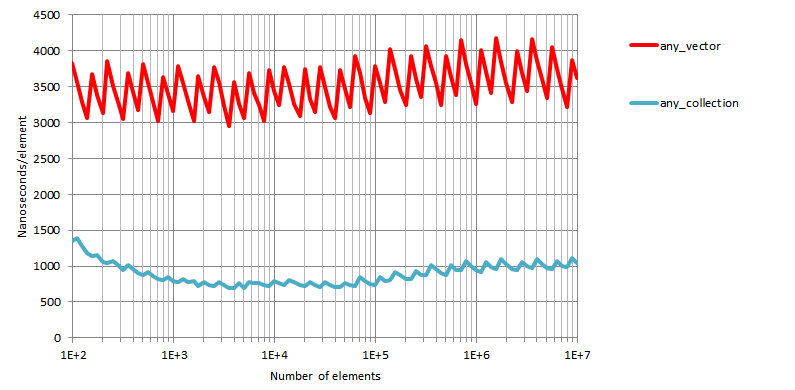 Insertion, Visual Studio
2015 x86
Insertion, Visual Studio
2015 x86
 Insertion, Visual Studio
2015 x64
Insertion, Visual Studio
2015 x64
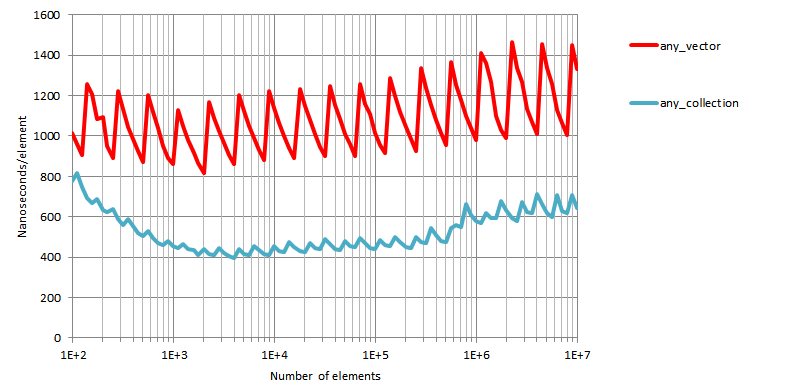 Insertion, GCC 6.3 x64
Insertion, GCC 6.3 x64
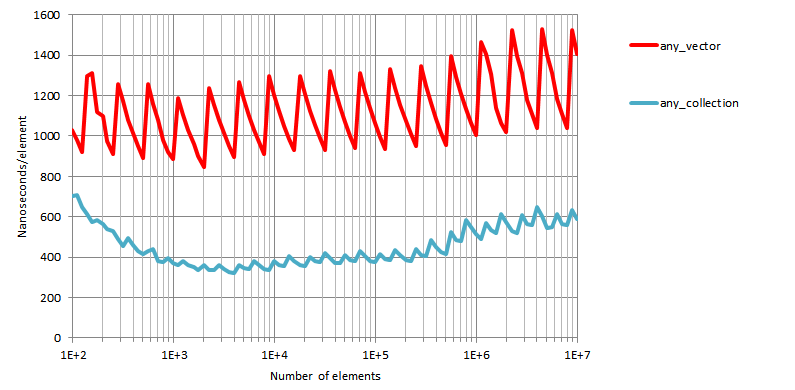 Insertion, Clang 4.0
x64
Insertion, Clang 4.0
x64
Tests measure the time taken to traverse a container of size n
(n between 102 and 107) and execute an operation on each
of its elements. The operation for boost::base_collection
and boost::function_collection (and the associated
baseline containers) is defined as
struct for_each_callable { for_each_callable():res{0}{} template<typename T> void operator()(T& x){ res+=x(2); } int res; };
whereas for boost::any_collection we use
struct for_each_incrementable { for_each_incrementable():res{0}{} template<typename T> void operator()(T& x){ ++x; ++res; } int res; };
The baseline container is tested with three different setups:
typeid().
This increases branch prediction efficiency at the expense of having
worse cache friendliness.
As for the polymorphic collection, three variations are measured:
std::for_each (the same as the baseline
container).
boost::poly_collection::for_each.
boost::poly_collection::for_each with type
restitution of T1,
T2 and T3.
The figures show resulting times in nanoseconds/element. The horizontal axis is logarithmic.
 Processing, Visual Studio
2015 x86
Processing, Visual Studio
2015 x86
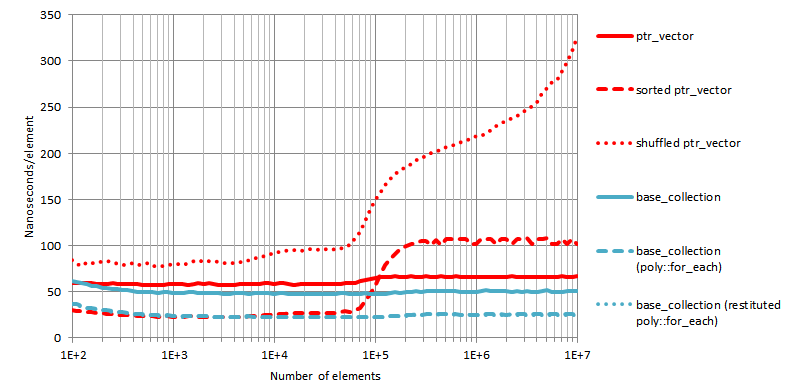 Processing, Visual Studio
2015 x64
Processing, Visual Studio
2015 x64
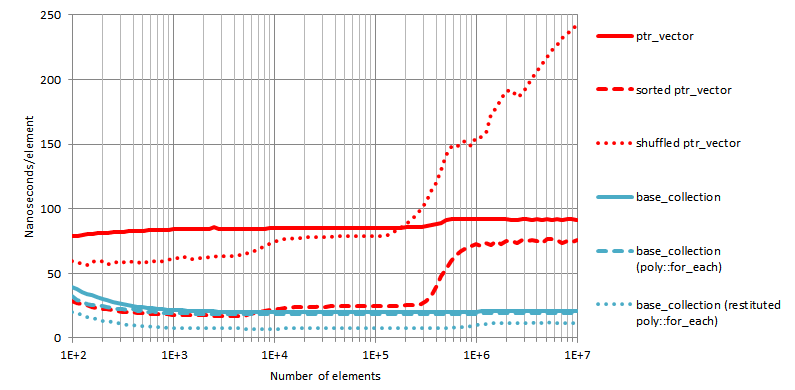 Processing, GCC 6.3
x64
Processing, GCC 6.3
x64
 Processing, Clang 4.0
x64
Processing, Clang 4.0
x64
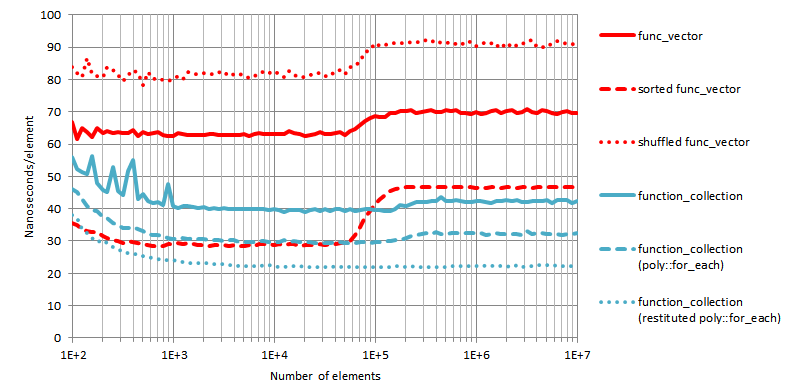 Processing, Visual Studio
2015 x86
Processing, Visual Studio
2015 x86
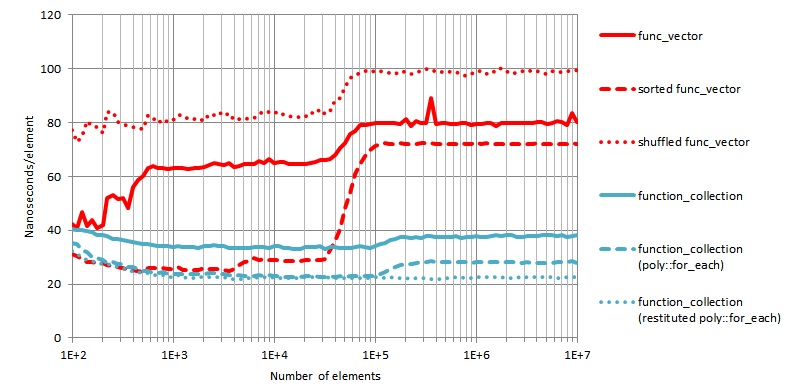 Processing, Visual Studio
2015 x64
Processing, Visual Studio
2015 x64
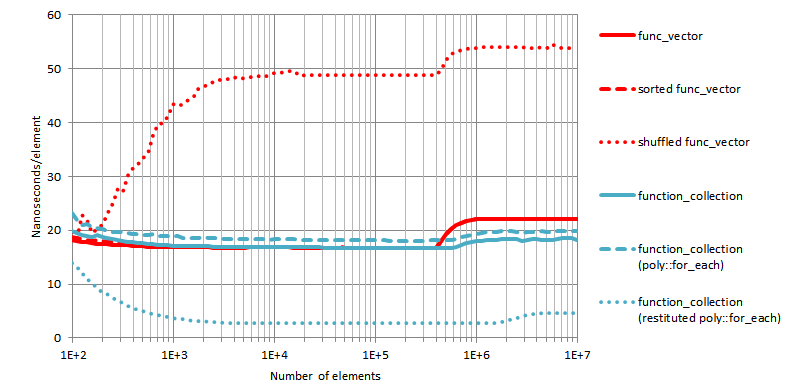 Processing, GCC 6.3
x64
Processing, GCC 6.3
x64
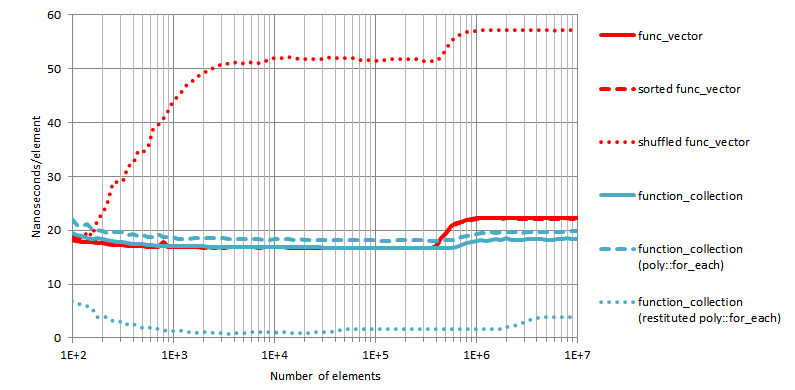 Processing, Clang 4.0
x64
Processing, Clang 4.0
x64
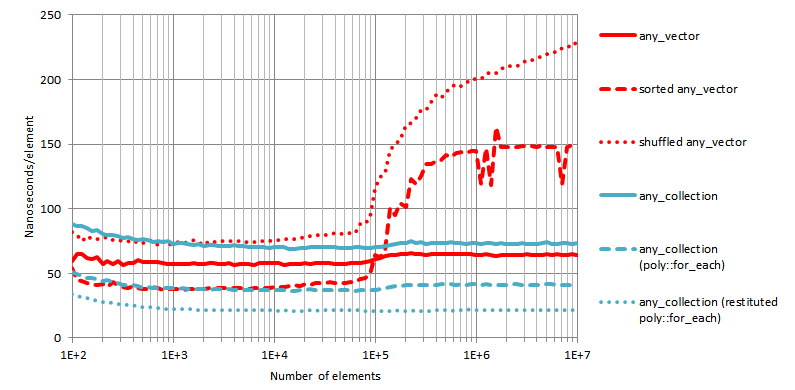 Processing, Visual Studio
2015 x86
Processing, Visual Studio
2015 x86
 Processing, Visual Studio
2015 x64
Processing, Visual Studio
2015 x64
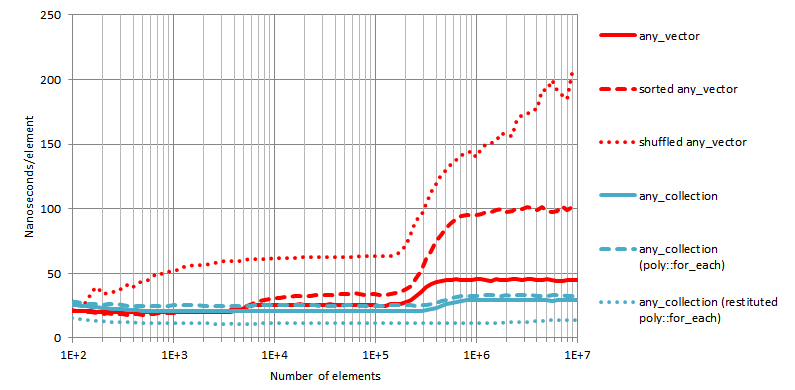 Processing, GCC 6.3
x64
Processing, GCC 6.3
x64
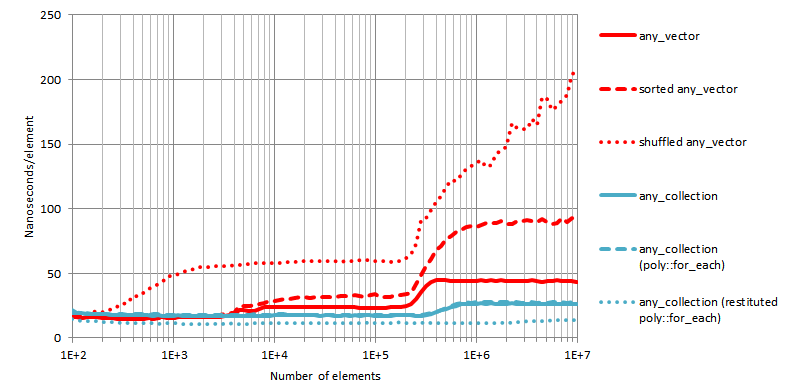 Processing, Clang 4.0
x64
Processing, Clang 4.0
x64